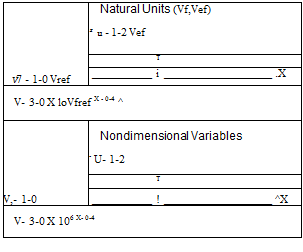Units and Parameters
1.5.1 Unit systems
The quantitative description of any physical system, such as a fluid flow, requires using some set of units.
Two alternative sets of units, compared in Figure 1.8, can be used to describe any one given situation.
• Standard Units. Examples are m, s, kg (SI), or ft, s, slug (English). These are universally known, and hence are most convenient for describing a specific physical object, and also for recording raw experimental data.
•
 |
 |
Natural Units (or Scales). Generic names are lref, Vref, pref, etc. Specific examples are c (chord), VL (freestream speed), pL (freestream density). These are most convenient for theoretical work, and for presenting reduced experimental data. Table 1.1 lists the scales which appear in aerodynamic flows.
Figure 1.8: Aerodynamic flow-field described in standard units, and alternatively in natural units. The natural units for this case are chosen to be the chord lref = c = 0.5m, and the freestream velocity Vref = VL = 10m/s. Using non-dimensional variables is equivalent to using natural units.
|
Table 1.1: Physical parameters, or scales, of aerodynamic flows. Scales in bottom block are relevant only for compressible flows. Units are: length l, time t, mass m, temperature 0.
|
The absolute reference pressure and temperature pref, Tref have been omitted from Table 1.1 because for ideal gases these are effectively redundant. Specifically, they can be defined from the other scales via the ideal-gas, speed of sound, and caloric relations.
pref — pref aref (1.43)
Tref — aref /cp (1.44)
Such derived-scale definitions only need to have the same dimensions. They do not need to be equalities, as in p = pa2/у and T = a2/(7—1 )cp. This allows the apparently missing 7 and 7—1 factors to be omitted from the pref and Tref definitions above.











